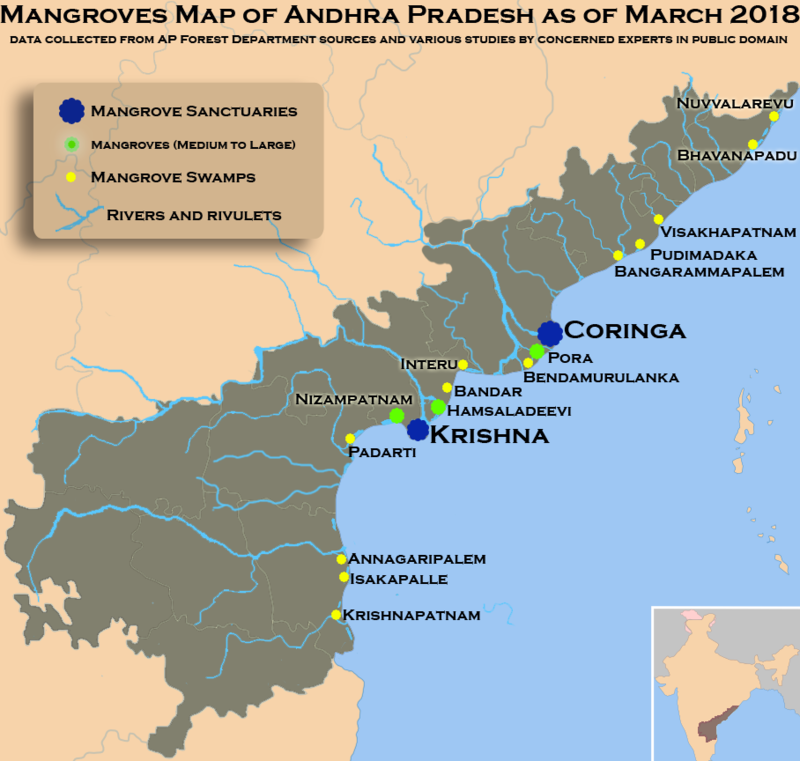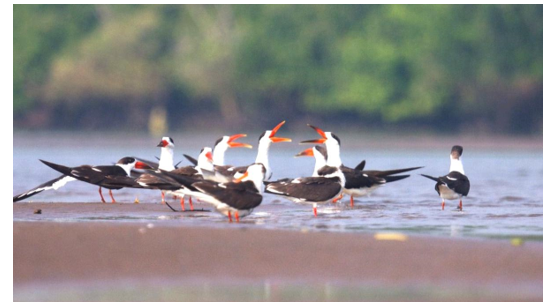12 Jan Estuary: Habitat of Indian Skimmer
Estuary: Habitat of Indian Skimmer
This article covers “Daily Current Affairs for UPSC “and the topic is about ‘Godavari estuary and Indian skimmer’ which is in the news, it covers the “Environment and ecology: Conservation” In GS-3, and the following content has relevance for UPSC.
For Prelims: Facts about Godavari estuary, Indian skimmer, Mangroves, Ramasar site
For Mains: GS-3, GS-1, Geography of Godavari estuary and Coringa Wildlife sanctuary, Mangroves, Ramasar site
Why In the news:
According to the deputy director of the Bombay Natural History Society (BNHS), the Godavari estuary in Andhra Pradesh has developed into an ideal and secure habitat for the Indian Skimmer (Rynchops albicollis).
About Godavari Sanctuary
- The Godavari Mangroves of the Coringa Wildlife Sanctuary (CWLS) are reputed to be the second-largest mangroves in India. The Sundarbans in West Bengal are the world’s largest mangrove forest.
- In the estuaries of the Krishna and Godavari rivers, Andhra Pradesh has mangrove forests. The Godavari mangroves are situated in the East Godavari district’s Godavari Estuary.

Mangroves map of Andhra Pradesh
The CWLS, which is situated in Andhra Pradesh, is home to several endangered species, including the fishing
- cat, Indian skimmer, otter, jackal, sea turtles, seagulls, pelicans, storks, herons, snipes, and flamingos, among others.
- Along with the mangrove forest, the sanctuary also has jurisdiction over Hope Island, a naturally created sandy stretch in the middle of the sea that has become synonymous with biodiversity.
- Olive Ridley Sea Turtles also annually nest at a location in the refuge from January to March.
- When UNESCO designates the Coringa sanctuary as a heritage site, both tourists and the wildlife that lives in the mangroves will benefit.
Estuary Ecosystem
- Where a river or a stream empties into the sea is known as an estuary (mouth of the river).
- It is a coastal region that is partially enclosed, brackish (salinity ranges from 0-35 ppt), has one or more rivers or streams running into it, and has a free connection to the open sea.
- Between river ecosystems and ocean settings, estuaries create an ecological transition zone (ecotone).
- River mouths, coastal bays, tidal marshes, lagoons, and deltas are all examples of estuaries.
- Estuaries are created as a result of tectonic activity, sea level rise, sand and sandbar movement, glacial activities, and sand migration.
- Every plant and animal in estuaries is exposed to salinity changes, to which they have evolved (osmoregulation).
- Tidal motion has a big impact on estuaries. Depending on how many tides there are, they receive a daily or twice-daily seawater wash.
- Tidal bores are important in some small estuaries. Tidal bores seriously harm the ecology of the estuary.
- Freshwater carrying fertile silt and runoff from the land combines with salty sea water at estuaries.
Importance of Estuary
- Because marine species from both ecosystems coexist in a zone of mixed freshwater and saline water, these bodies of water are the most productive in the world (more productive than wetlands).
- Mangroves, wetlands, estuaries, grasslands, and other ecotone regions (transitional zones) have far higher productivity levels than natural ecosystems such as forest ecosystems, ocean ecosystems, pond ecosystems, riverine ecosystems, desert environments, etc. This is a result of the diverse species from the nearby ecosystems existing in the ecotone.
- Additionally, an estuary has relatively little wave activity, making it a peaceful haven from the open sea that is suitable for the survival of many aquatic species.
- During storms and strong landward winds, the extensive mangrove forests on an estuary’s seaward side serve as a barrier to keep the wind from reaching the coastal habitat.
- Mangroves serve as a filter, capturing muck and sand carried downstream by rivers, causing deltas to form around estuaries.
- Due to the exposure to salt water, clay, and alluvium particles precipitate frequently in the estuary region (saline water precipitates fine alluvium).
- Estuaries serve as a barrier between coastal catchments and the marine environment by storing and recycling nutrients, trapping sediment, and trapping water.
- They serve as a natural water filter by absorbing, trapping, and detoxifying contaminants.
- Fisheries are among the many natural resources found in estuaries, which also have wetlands, creeks, lagoons, mangroves, and seagrass beds.
- As a result, they make excellent places for ports and harbors because they are deep and well-protected from maritime infractions.
- Human settlements often locate themselves along the banks of estuary channels. These towns use the estuaries for commercial and recreational purposes, as well as for the disposal of municipal and industrial waste today.
The Indian Skimmer (Rynchops albicollis)
- The Indian skimmer’s large, orange-yellow beak and slightly longer lower mandible (jaw) are two of its most distinctive characteristics (Rynchops albicollis).
- The maximum length of the Indian Skimmer:40-43 cm

Indian Skimmer
Distribution
- The coastal estuaries of western and eastern India are home to the Indian skimmer, which is more prevalent during the winter months.
- Larger, sandy lowland rivers, lakes, and nearby marshes are its main habitats. During the non-breeding season, estuaries and coastlines are also where you can find it.
- Less than 2,500 birds make up the population, and about 20% of them nest along the Chambal River.
- The species is found in India near the Chambal river in Central India, in a few locations in Odisha, and in Andhra Pradesh.
- IUCN Red List: Endangered
- CITES Status: Not included.
Threat
- Its population reduction is primarily due to the loss of wetlands and riverine habitats.
- The damming of the Chambal River in upstream Rajasthan has had a detrimental effect on its population at the National Chambal Sanctuary in Uttar Pradesh because the reduced water levels allowed predators and cattle access to breeding islands.
Source:
Download the PDF Now
Daily Current Affairs for UPSC
Current Affairs are very helpful for passing the UPSC examination. It helps to enhance the general knowledge of UPSC aspirants. Here Plutus IAS delivers the best daily Current affairs for the UPSC examination free of cost. So, today, collect the latest current affairs from us and read them properly for the IAS examination. Also, get weekly and monthly Current Affairs for IAS exam preparation.




No Comments